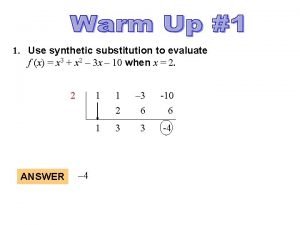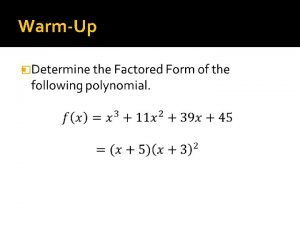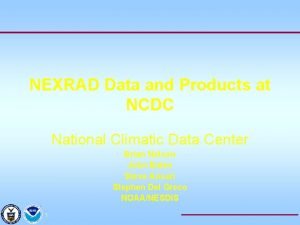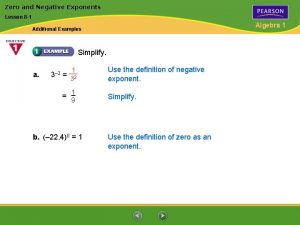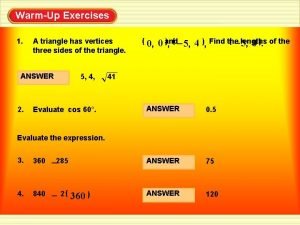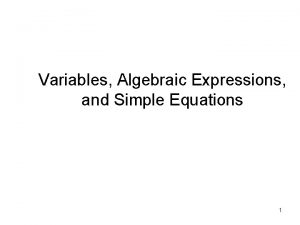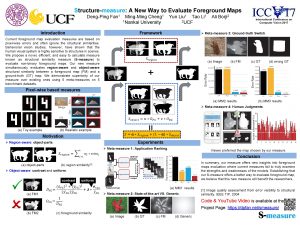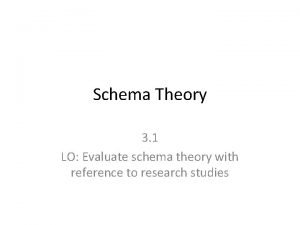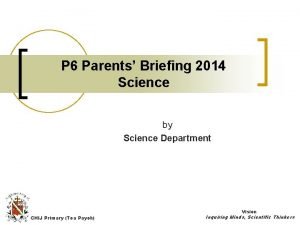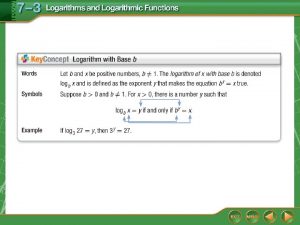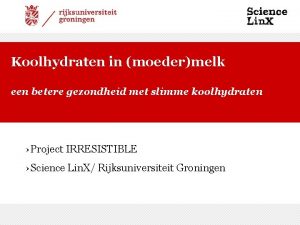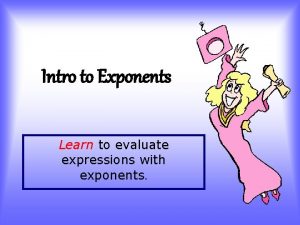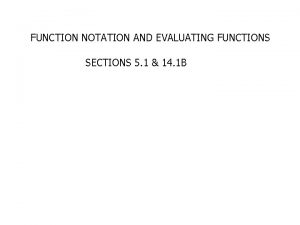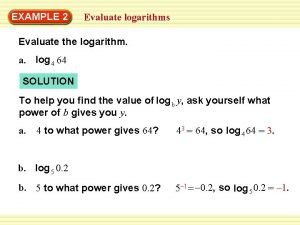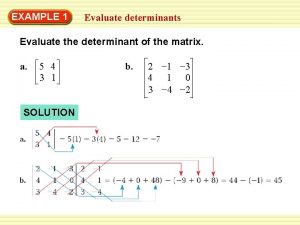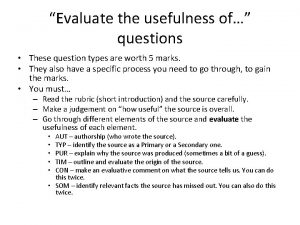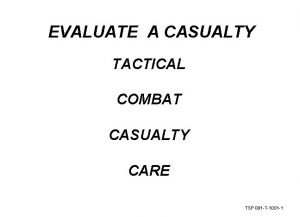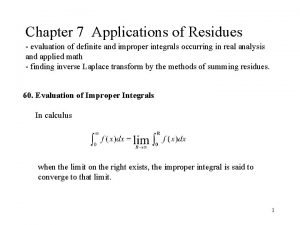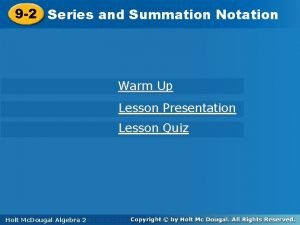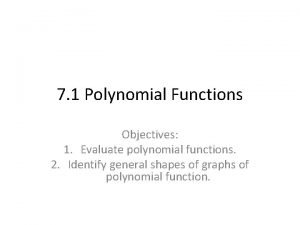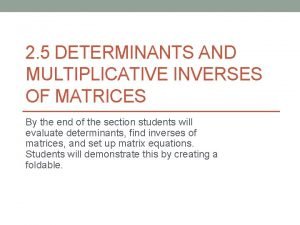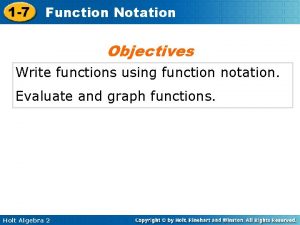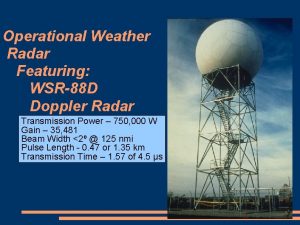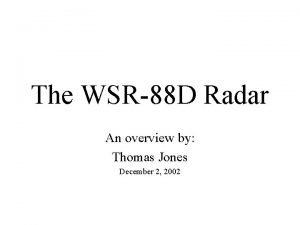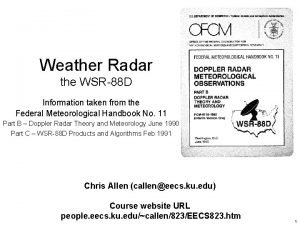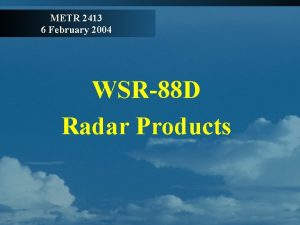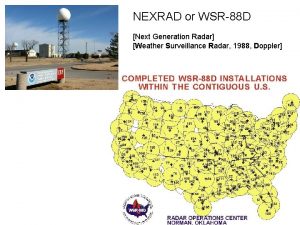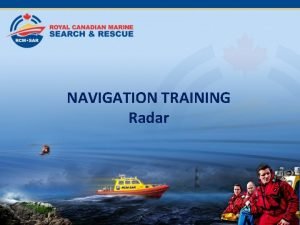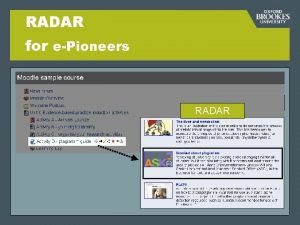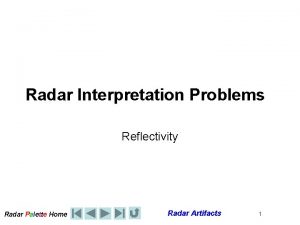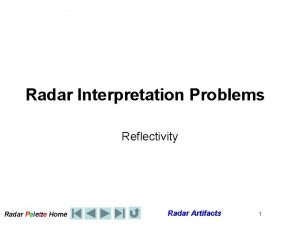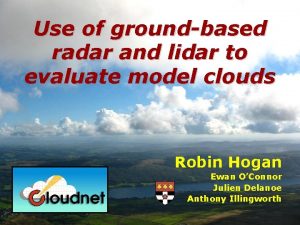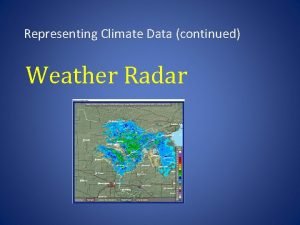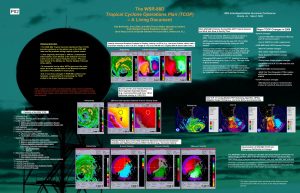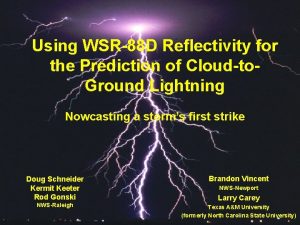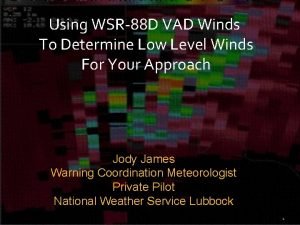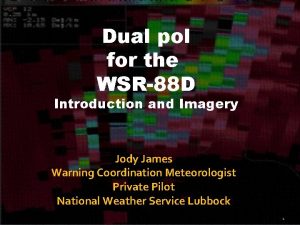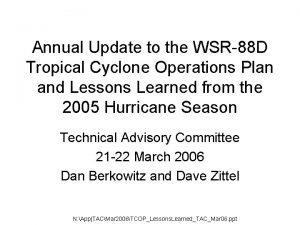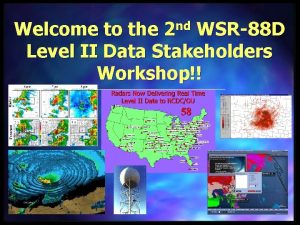Use of WSR88 D radar data to evaluate







































- Slides: 39

Use of WSR-88 D radar data to evaluate regional model forecasts Sandra Yuter North Carolina State University October 2005

Outline Comparison of 3 D radar and forecast model output n Mixed precipitation n Draft plan for observations in Carolinas n 2

Use of observations for model evaluation and diagnosis What structural characteristics of storms are most important to reproduce in numerical models? n What subset of characteristics can we most reliably observe? n How do we distinguish between details that are unique to an individual storm versus those that are repeated among a group of storms? n 3

Routine Daily comparison of observations to forecast model output n Directly comparable products derived from observations and model output yield objective measures of: Confidence in forecast model output for particular storm type n Model strengths and weaknesses n Evaluation of proposed model changes n Diagnosis of error sources n 4

What should the model/observations comparison products look like? 5

Model to Observation Comparison of Surface Rainfall 1 km cloud resolving model with explicit microphysics (ARPS) of Ft. Worth Texas storm for time=0 (Smedsmo et al, 2005) 6

Volumetric comparison for accumulated storm totals 7 Smedsmo et al. (2005)

Evaluation of Model Output must be 3 D! n Surface fields necessary but not sufficient for comparisons n Operational WSR-88 D radar can provide 3 D precipitation structure and wind field information Supplemental vertically-pointing radar can provide fine-scale information on freezing level and subgrid scale variability n 8

Prototype Concepts in Portland, Oregon Area 120 km radius from KRTX 9

METEK Inc. Radar in Scholls, OR Ku-band (1. 25 cm wavelength) Cost ~ $16 K Resolution 150 m Measurements of: n Doppler velocity n d. BZ- attenuates in moderate to heavy rain 10

Microphysical and Observational Context Fall velocity Radar reflectivity Snow Layer 0 C Melting Layer Rain Layer Vertically-pointing radar Ground Surface 11

UTC Time (hours) m/s Height (m) d. BZ Variable freezing level UTC Time (hours) 12

UTC Time (hours) m/s Height (m) d. BZ Variable freezing level UTC Time (hours) 13

UTC Time (hours) m/s Height (m) d. BZ Variable freezing level UTC Time (hours) 14

What sub area around radar can we use for comparisons? Radar Visibility: n Total n Partial n Blocked 15

Interpolate Polar Radar Data to Cartesian Coordinate System WSR-88 D Precip Scan • Spatial coordinates similar to model • Minimize range dependence of radar data 16

31 Dec - 1 Jan storm Wind Field (radial velocity) 1. 0 km altitude Freq. of Echo 13 d. BZ 17

31 Dec - 1 Jan storm Wind Field (radial velocity) 3. 0 km altitude Freq. of Echo 13 d. BZ 18

17 - 18 Jan 2005 storm Wind Field (radial velocity) 1. 0 km altitude Freq. of Echo 13 d. BZ 19

17 - 18 Jan 2005 storm Wind Field (radial velocity) 3. 0 km altitude Freq. of Echo 13 d. BZ 20

B. Colle MM 5 output Distance (km) WSR-88 D Observation Distance (km) 21

Findings Orography limits radar’s visibility, compare with model over subarea of domain n Interpolate radar data to Cartesian grid n minimize range dependence n common coordinate system with model n n Variable freezing level height in winter complicates use of quantitative d. BZ statistics 22

Suggested Observed 3 D Characteristics for Forecasts of Winter Storms to Reproduce From WSR-88 D: n Wind field pattern (radial velocity) n Precipitation frequency pattern From vertically-pointing radar n Freezing level altitude (location, time) 23

PARSIVEL disdrometer: simultaneously measures diameter and fall speed of particles Löffler-Mang and Joss (2000) 24

Mc. Kenzie Bridge, Oregon (494 m MSL) MKB Observation Locations Steamboat Springs, Colorado (3200 m MSL) SPL 25

MKB 17 December 2001 Rising Temperature: 2. 5 o. C to 5. 5 o. C Rain r g Lump graupel, Locatelli and Hobbs (1974) Log 10(# of particles) Fall Velocity (m/s) Rain, Berry and Pranger (1974) d Unrimed dendrites, Locatelli and Hobbs (1974) D (mm) 26

SPL 27 February 2003 Falling Temperature: -5 o. C to -10 o. C r g Log 10(# of particles) Fall Velocity (m/s) Dry Snow d D (mm) 27

MKB 19 December 2001 Steady Temperature: 0. 0 o. C r g Log 10(# of particles) Fall Velocity (m/s) Period C d D (mm) 28

MKB 18 -19 December 2001 Falling Temperature: 0. 5 o. C to 0. 0 o. C r g Log 10(# of particles) Fall Velocity (m/s) Period B d D (mm) 29

Precipitation Classification Fall Velocity (m/s) Rain r g Not Rain d Ambiguous D (mm) 30

MKB 18 -19 December 2001 r g Log 10(# of particles) Fall Velocity (m/s) Rain Subset d D (mm) 31

MKB 18 -19 December 2001 r g Log 10(# of particles) Fall Velocity (m/s) Not-Rain Subset d D (mm) 32

Relative proportions of rain subset of particles during mixed precipitation at Mc. Kenzie Bridge, OR. Air Temp 0°C 0. 5°C-0°C 1. 5°C 0. 5°C % rain particles of total conc (# m-3) 5% 23% % rain volume of total vol. 1% 4% Average rain rate (mm hr-1) 0. 09 1. 0 93% 74% 2. 3 Statistics are calculated for subset of particles with 1 mm ≤ D ≤ 10 mm. 33

34

North Carolina Planned New Observations n Initial Phase (Winter 2005 -2006) n n n Clayton DAQ site (Spring 2006) n n n Micro. Rain. Radar at Raleigh NWSFO Precip instrument test including PARSIVEL Micro. Rain. Radar PARSIVEL precip type Mt. Mitchell (Winter 2006) n n n Micro. Rain. Radar PARSIVEL precip type Snow measurement (hopefully) 35

Long Term Possibilities n NOAA Hydrometeorology Testbed (HMT) moves to Appalachians (~2010) Likely Tar River Basin n Many observation resources n Seasonal operations over several years n n Carolina Experiment (2015? ) in coordination with NOAA HMT intensive field phase 36

Archived Level 2 WSR-88 D data is being used for research! n Preferred VCPs for precip n VCP 11 – 14 elevation angles n VCP 21 – 9 elevation angles n VCPs to avoid n VCP 121 – smears rapidly moving storms n VCP 12 – faster antenna rotation degrades Vr and Z data 37

Cooperative studies n Important to Operations n Interesting for Basic Science n Practical n Able to make quality observations n High potential to make progress 38

The End 39
 Difference between pulse doppler radar and mti radar
Difference between pulse doppler radar and mti radar Pulse doppler radar vs mti
Pulse doppler radar vs mti Evaluate using synthetic substitution
Evaluate using synthetic substitution Synthetic substitution worksheet
Synthetic substitution worksheet Ncdc radar data
Ncdc radar data How you use ict today and how you will use it tomorrow
How you use ict today and how you will use it tomorrow Zero negative exponents
Zero negative exponents Examples of internal forms of social control
Examples of internal forms of social control Trigonometry table
Trigonometry table Expression vs equation
Expression vs equation Cognitive psychology essay
Cognitive psychology essay Structure-measure: a new way to evaluate foreground maps
Structure-measure: a new way to evaluate foreground maps Darley and gross 1983
Darley and gross 1983 Evaluate
Evaluate Infix equation
Infix equation Engage explore explain elaborate evaluate
Engage explore explain elaborate evaluate How to write log in exponential form
How to write log in exponential form Engage explore explain elaborate evaluate
Engage explore explain elaborate evaluate Site:slidetodoc.com
Site:slidetodoc.com Evaluate 32 3/5
Evaluate 32 3/5 Square roots
Square roots Higher pe questions
Higher pe questions How to answer source based questions in history
How to answer source based questions in history How to evaluate a function
How to evaluate a function Simplify 64:24
Simplify 64:24 Evaluating logarithms practice
Evaluating logarithms practice Evaluate the determinant
Evaluate the determinant Evaluate the limit
Evaluate the limit I can evaluate functions
I can evaluate functions Evaluate the usefulness
Evaluate the usefulness 081-com-1001
081-com-1001 Synthetic substitution example
Synthetic substitution example Plan together in community mobilization
Plan together in community mobilization Application of residue theorem to evaluate real integrals
Application of residue theorem to evaluate real integrals Application of residue theorem to evaluate real integrals
Application of residue theorem to evaluate real integrals Assure model lesson plan physical education
Assure model lesson plan physical education How to express summation notation
How to express summation notation Evaluation of polynomial function
Evaluation of polynomial function How to evaluate the determinant of a matrix
How to evaluate the determinant of a matrix Function notation
Function notation


